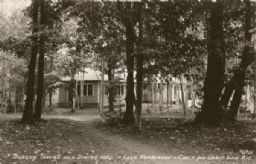
The source I decided to use is another secondary source from a page out of a Wisconsin Magazine of History. The edition was published in 1988. The edition focuses on how life was in rural Wisconsin throughout the 1940’s. This made for an interesting read because on page 15, the article goes in depth about how taverns impacted the lives of communities and families.
This excerpt from the magazine seemed to relate to my research the most:
“On Friday and Saturday nights, entire families crowded into nearby taverns to par- take of a fish fry or the other weekend special- ties of the house and then to enjoy the company of friends and neighbors. For the tavern in Wisconsin was, more often than not, a place that attracted women as well as men, and the children they brought with them. This was particularly true in communities made up of people of German and other central and east-ern European descent, where beer, wine, and spirits were an integral part of nearly every celebration and social gathering.”
This excerpt, even though it is short in length, caught my attention right away! I was first glad to hear that families would crowd the tavern to indulge in fish fries, but I was also glad to read about how taverns in Wisconsin were a place of community and celebration. The German influence in many communities had this impact on their local taverns in the 40’s because of their cultural tradition. This idea of the German inclusion into Wisconsin history and especially fish fries has been very useful to my research topic. The final thing that stuck with me from this article was how it described women and their involvement with taverns. The article states that women would then bring their children and before you know it a whole community was connecting at a large friendly social gathering.
This article made me realize how much my hometown is still like Cable, Wisconsin even in today’s society. I worked at a supper club on the lake in my hometown and Friday nights were always the busiest nights for us. Families crowded the doors and would wait for up to two hours for a table. This whole idea of community involvement at a tavern is quite familiar to me. Looking to see how we got where we are today because of our German heritage and large Roman Catholic influence is quite interesting. If both of the factors were not major impacts in Wisconsin, who knows if the Friday night fish fry would even be that big of a deal?
This article is good at using rhetoric throughout the entire magazine. Pathos are one term that really connected to me personally as I read this article because I felt connected to what people in the 1940’s did on their normal journey to a tavern. Overall this made me feel intimate with my own family and our traditions of gathering with friends at local taverns in my hometown. This magazine has credible ethos because it is historic and yet it still exists today.
Works Cited:
Thompson, William F. “1940.” Wisconsin Magaizne of History Autumn 1988: 15. Print.
After reading what you had to say about your third source, I think that this source seems like a credible one. However, after saying this, I didn’t really get too much of a sense of what you learned from this, and how it helped you in the process of answering your research question more. I really like that you included a link for us to go check out the article ourselves, and since it is from the Wisconsin Magazine of History, I think that this could be useful. You could try to explain how this source connects to your learning experience more, but overall this topic is very interesting and you seem like you are on a good track!
I like how you started off with a quote from this source, it made me want to read more. Even though the article was sort, it gave a lot of information and now I understand what goes on at fish fries in Wisconsin. I think its cool that you can relate to your research question. Good job!